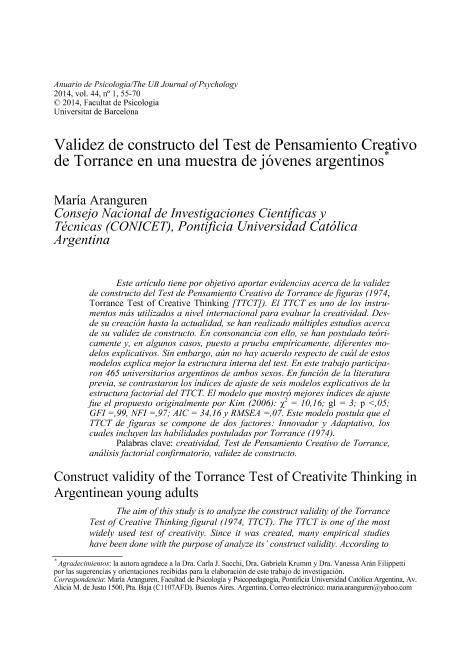Mostrar el registro sencillo del ítem
dc.contributor.author
Aranguren, María

dc.date.available
2020-04-01T19:58:26Z
dc.date.issued
2014-06
dc.identifier.citation
Aranguren, María; Validez de constructo del Test de Pensamiento Creativo de Torrance en una muestra de jóvenes argentinos; Universidad de Barcelona. Facultad de Psicología; Anuario de Psicología; 44; 1; 6-2014; 55-70
dc.identifier.issn
0066-5126
dc.identifier.uri
http://hdl.handle.net/11336/101576
dc.description.abstract
Este artículo tiene por objetivo aportar evidencias acerca de la validez de constructo del Test de Pensamiento Creativo de Torrance de figuras (1974, Torrance Test of Creative Thinking [TTCT]). El TTCT es uno de los instrumentos más utilizados a nivel internacional para evaluar la creatividad. Desde su creación hasta la actualidad, se han realizado múltiples estudios acerca de su validez de constructo. En consonancia con ello, se han postulado teóricamente y, en algunos casos, puesto a prueba empíricamente, diferentes modelos explicativos. Sin embargo, aún no hay acuerdo respecto de cuál de estos modelos explica mejor la estructura interna del test. En este trabajo participaron 465 universitarios argentinos de ambos sexos. En función de la literatura previa, se contrastaron los índices de ajuste de seis modelos explicativos de la estructura factorial del TTCT. El modelo que mostró mejores índices de ajuste fue el propuesto originalmente por Kim (2006): χ2 = 10.16; gl = 3; p <.05; GFI =.99, NFI =.97; AIC = 34.16 y RMSEA =.07. Este modelo postula que el TTCT de figuras se compone de dos factores: Innovador y Adaptativo, los cuales incluyen las habilidades postuladas por Torrance (1974).
dc.description.abstract
The aim of this study is to analyze the construct validity of the Torrance Test of Creative Thinking figural (1974, TTCT). The TTCT is one of the most widely used test of creativity. Since it was created, many empirical studies have been done with the purpose of analyze its’ construct validity. According to this, several theoretical models have been postulated in previous studies but to date the findings are still mixed and inconclusive. In this research, respondents consisted of 465 university students of both genders. Confirmatory factor analyses were conducted and six factor models were tested to analyze which of them best explain the operationalized creativity construct with the TTCT. The model that better fit the data was the original model proposed by Kim (2006): χ 2 = 10.16; gl = 3; p <.05; GFI =.99, NFI =.97; AIC = 34.16 and RMSEA =.07. This model postulate that the TTCT is composed by two factors: (a) Innovation and (b) Adaptation. Both factors include the five subscales proposed by Torrance (1974).
dc.format
application/pdf
dc.language.iso
spa
dc.publisher
Universidad de Barcelona. Facultad de Psicología
dc.rights
info:eu-repo/semantics/openAccess
dc.rights.uri
https://creativecommons.org/licenses/by-nc-sa/2.5/ar/
dc.subject
Creatividad
dc.subject
Test de pensamiento creativo de Torrance
dc.subject
Análisis factorial confirmatorio
dc.subject
Validez de constructo
dc.subject.classification
Otras Psicología

dc.subject.classification
Psicología

dc.subject.classification
CIENCIAS SOCIALES

dc.title
Validez de constructo del Test de Pensamiento Creativo de Torrance en una muestra de jóvenes argentinos
dc.title
Construct validity of the Torrance Test of Creativite Thinking in Argentinean young adults
dc.type
info:eu-repo/semantics/article
dc.type
info:ar-repo/semantics/artículo
dc.type
info:eu-repo/semantics/publishedVersion
dc.date.updated
2020-03-19T19:38:12Z
dc.journal.volume
44
dc.journal.number
1
dc.journal.pagination
55-70
dc.journal.pais
España

dc.journal.ciudad
Barcelona
dc.description.fil
Fil: Aranguren, María. Pontificia Universidad Católica Argentina "Santa María de los Buenos Aires". Facultad de Psicología y Psicopedagogía. Centro de Investigaciones en Psicología y Psicopedagogía; Argentina. Consejo Nacional de Investigaciones Científicas y Técnicas; Argentina
dc.journal.title
Anuario de Psicología
dc.relation.alternativeid
info:eu-repo/semantics/altIdentifier/url/https://revistes.ub.edu/index.php/Anuario-psicologia/article/view/10217
Archivos asociados
